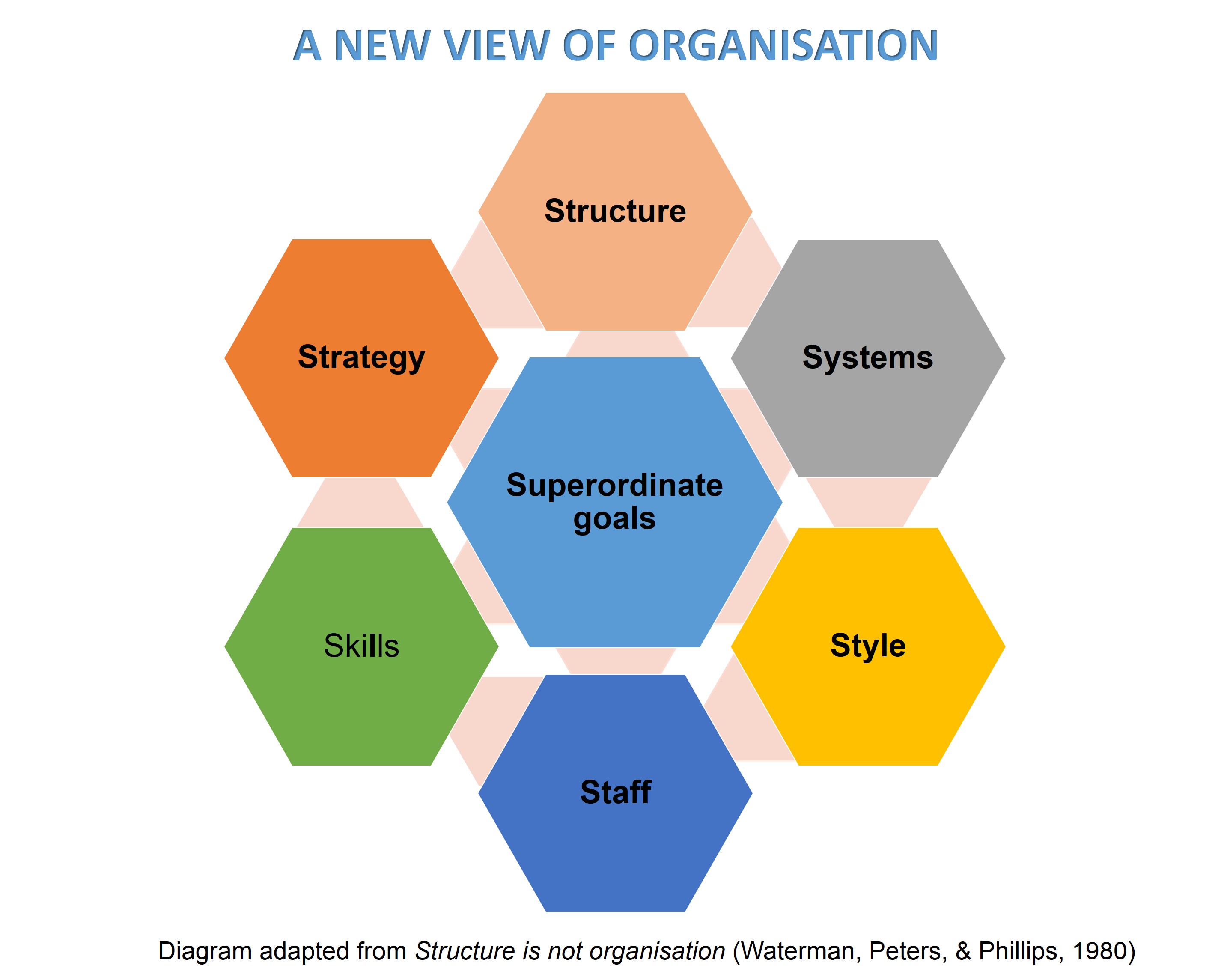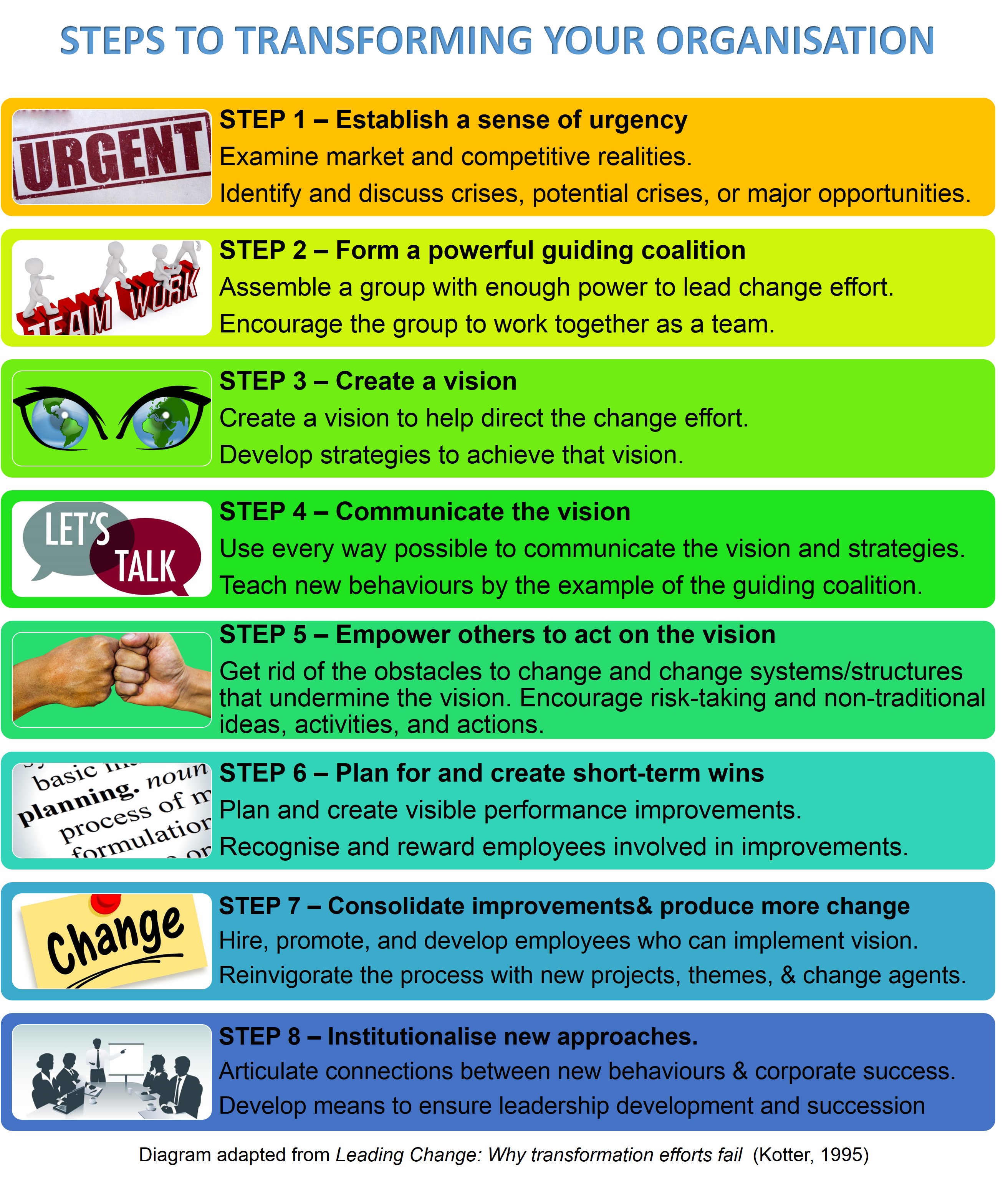
In order to deal with obstacles within an organisation and ensure consistent progress and long-term success, you must change your organisational culture. This has been discussed in our previous lectures. In this lecture we will outline how to use the 7-S Framework and John Kotter's 8 steps to change your organisation.
For a long period, the only model for organisational change was one comprising only two parts: structure, and strategy. It has become known, however, that focusing solely on structure or strategy is primarily where many organisations fail when attempting to adapt to change or progress. Thus, the structure or strategy of the organisation must not become the only focus of reorganisation to implement the necessary changes. Transforming organisations requires the implementation of frameworks that include relationships between organisational structural and strategy as well as other internal areas. Following the necessary steps to achieve this will allow the essential organisational change that facilitates improvement and long-term success.
The 7-S Framework
The 7-S framework was established to ensure that organisational transformation focussed on the relationships between organisational structure, strategy, systems, skills, staff, and superordinate goals. This is depicted in the diagram below.

The framework highlights several important ideas that support its effectiveness in establishing change within the organisation. These include:
- Multiplicity factors that influence the organisation’s ability to change and transform effectively. By only focussing on organisational structure or strategy, all other factors are ignored and transformation is not as effective as it could be. These multiple factors are also depicted in the above diagram.
- As shown in the diagram, all the aforementioned factors are interconnected emphasising the fact that it becomes increasingly difficult to make significant progress or change in one area without affecting the other areas. Ignoring the interconnectedness of all change factors becomes dangerous as it does not facilitate operative progress and transformation.
All these variables must be considered when attempting to assess obstacles faced by the organisation or when attempting to transform the organisation for the better. By doing this, adaption to change is facilitated more efficiently, thus, furthering organisational transformation and success.
Steps have been identified and compiled that can assist in shifting the organisation’s focus to include all of these important variables.
Steps to Transforming your Organisation
In order to facilitate effective organisational change, common errors that lead to the failure of transformation efforts must be avoided. These have been described by John Kotter as :
- Not establishing a sense of urgency.
- The lack of a powerful guiding coalition.
- Lack of a vision.
- Under-communication of the vision.
- Not removing the obstacles faced by the new vision.
- Lack of systematic planning for and creating short-term wins.
- Declaring victory too soon.
- Not anchoring changes within the organisation’s culture.
Taking steps to avoid the problematic errors mentioned above will ensure that organisation has a set direction towards which to move, a better way to manage any obstacles faced, and a positive change in the organisation’s culture that will facilitate transformation and progression towards the achievement of essential goals and positive long-term results. Additionally, this will ensure that all the aforementioned interconnected factors are taken into consideration for optimal organisational change and transformation.
These steps to transformation your organisation are illustrated in the diagram below.

Conclusion
Organisational transformation and ability to adapt to change is essential for the progress and positive development of its culture and overall corporate success. Frameworks, such as the 7-S framework, should be adapted within organisations over and above the traditionally used two-part model. This will ensure that all essential interconnected factors within the organisation are addressed, thus, allowing for more effective management and change. Steps should be taken to avoid common errors made to ensure that these transformation efforts do not fail. By doing this, organisations can not only change their culture in a positive way, but also shift from a slower, less capable system of change adaption to a swifter, more progressive and efficient method of transformation. Consequently, dealing with problems and obstacles becomes more effective, benefiting the organisation and its success greatly, particularly in the long-term.
References
Kotter, J. P., 1995. Leading Change: Why Transformation Efforts Fail. Harvard Business Review, pp. 59-67.
Waterman, R. H., Peters, T. J. & Phillips, J. R., 1980. Structure is not organisation. Business Horizons, pp. 14-26.
Previous Post |
Next post |
Organisational culture types |
Agile Organisational Models |